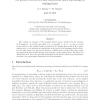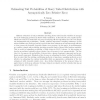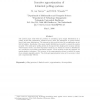105
Voted
QUESTA
2007
15 years 3 days ago
2007
We consider an extension of the standard G/G/1 queue, described by the equation W D = max{0, B − A + Y W}, where P[Y = 1] = p and P[Y = −1] = 1 − p. For p = 1 this model red...
96
Voted
QUESTA
2007
15 years 3 days ago
2007
We propose a new queueing model named the acquisition queue. It differs from conventional queueing models in that the server not only serves customers, but also performs acquisit...
QUESTA
2007
15 years 3 days ago
2007
This paper investigates stability behavior in a variant of a generalized Jackson queueing network. In our network, some customers use a join-the-shortest-queue policy when enterin...
113
click to vote
QUESTA
2007
15 years 3 days ago
2007
Efficient estimation of tail probabilities involving heavy tailed random variables is amongst the most challenging problems in Monte-Carlo simulation. In the last few years, appli...
113
Voted
QUESTA
2007
15 years 3 days ago
2007
We consider a variant of the two node tandem Jackson network where the upstream server reduces its service rate when the downstream queue exceeds some prespecified threshold. The...
QUESTA
2007
15 years 3 days ago
2007
Recently, a state-dependent change of measure for simulating overflows in the two-node tandem queue was proposed by Dupuis et al. (Ann. Appl. Probab. 17(4):1306– 1346, 2007), to...
QUESTA
2007
15 years 3 days ago
2007
95
Voted
QUESTA
2007
15 years 3 days ago
2007
The present paper deals with the problem of calculating queue length distributions in a polling model with (exhaustive) k-limited service under the assumption of general arrival, ...
101
Voted
QUESTA
2007
15 years 3 days ago
2007
We present the queueing analysis of a degenerate buffer having access to a single server. This system cannot realize any given delay, but only values that are an integer multiple ...
68
Voted
QUESTA
2007
15 years 3 days ago
2007



